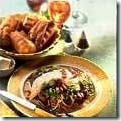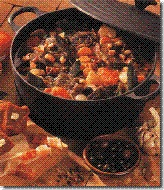Now that the summer is winding down and most of the outdoor chores are on hold I’ve had time to get back into the kitchen. Now seemed like a good time to refresh my recipe repertoire. In searching some cookbooks and magazines I found an article in the Fine Cooking magazine, March 2007 #84 titled “Bistro Cooking at Home”. I have always been a big fan of bistro style cooking so it was off to Michael’s market for the needed ingredients.
The first dish we tried was “Chicken with Vinegar & Onions”  or “Poulet au Vinaigre”. My short review of this recipe; I now have a new favorite chicken dish. This dish is fancy enough for a traditional Sunday dinner but simple enough for a weeknight. In fact the recipe gives some hints for fixing this a day or two in advance. The remainder of the meal made great leftovers the following night. This recipe takes chicken to new level.
or “Poulet au Vinaigre”. My short review of this recipe; I now have a new favorite chicken dish. This dish is fancy enough for a traditional Sunday dinner but simple enough for a weeknight. In fact the recipe gives some hints for fixing this a day or two in advance. The remainder of the meal made great leftovers the following night. This recipe takes chicken to new level.
There is nothing in this recipe that I feel needed to be changed and the most exotic ingredients were; depending on your pantry, fresh tarragon or Champagne vinegar. Try this recipe it could become a new hit in your kitchen.
Chicken with Vinegar & Onions
Poulet au Vinaigre
Fine Cooking March 2007 #84
Serves four to six.
3 Tbs. unsalted butter
2 medium-small yellow onions, thinly sliced (about 2cups)
Kosher salt and freshly ground black pepper
3 Tbs. Champagne vinegar.
1 4-lb. chicken, cut into 8 pieces.
½ cup all-purpose flour.
2 Tbs. extra-virgin olive oil.
½ cup dry white wine, such as Sauvignon Blanc
2 tsp. chopped fresh tarragon leaves
2 Tbs. heavy cream or creme fraiche
In a 12-inch skillet, melt 2 Tbs. of the butter over medium heat. Add the onions, sprinkle with a couple of big pinches of salt and a few grinds of pepper, and stir to coat the onions. Cover, reduce the heat to medium low, and continue to cook, stirring occasionally, until the onions are tender and lightly browned, about 20 minutes. Scrape them into a small bowl and set the skillet over medium-high heat. Add 1 Tbs, of the vinegar and stir with a wooden spoon to dissolve any browned bits on the bottom of the pan. Pour the vinegar into the onions and set the skillet aside.
If using chicken parts, cut each breast crosswise into two equal-size portions and trim any excess fat or skin from the thighs. Rinse and pat dry.
Spread the flour in a pie plate, and season the chicken pieces with salt and pepper. Set the skillet over medium-high heat and add the olive oil and the remaining 1 Tbs. butter. While the butter melts, dredge half of the seasoned chicken pieces in the flour, shaking off the excess. Set them skin side down in the skillet. Brown, turning once, until the skin is crisp and the chicken is evenly browned, 6 to 8 minutes total. Lower the heat if the chicken or the drippings threaten to burn. Transfer the chicken pieces to a pan or platter and repeat with the remaining chicken.
When all the chicken is browned, pour off all of the fat. Return the skillet to medium-high heat, add the wine, and scrape the bottom of the pan with a wooden spoon to dissolve the drippings. Add the remaining 2 Tbs. of vinegar, the sauteed onions, and 1 tsp. of the tarragon. Return the chicken pieces, skin side up, to the skillet, arranging them in a single snug layer. Partially cover, leaving a small gap for the steam to escape, and lower the heat to maintain a low simmer. Continue to simmer gently, turning every 10 minutes, until the chicken is tender and cooked through, about 30 minutes total.
Transfer the chicken to a platter. Increase the heat to a more rapid simmer, and stir in the creme fralche (or cream); the sauce may appear broken at first, but it will come together. Taste for salt and pepper. Add the remaining 1 tsp. tarragon and spoon over the chicken to serve.
The second recipe we tried was the beef classic “Beef Stew with Red Wine & Carrots” or “Daube de Boeuf aux Carottes”  This simple but savory dish was also easy to fix, the recipe called for a few more ingredients with the most exotic being. herbes de Provence. In fact this is one area I would make a change, the recipe calls for 2 tsp of the herb mixture. I will try just 1 tsp the next time I make this, I found the herbs to on the edge too much, but this mixture, varies greatly depending on who put the mix together and how fresh the mix is. One other thing I might change is the cooking time, at 45 minutes the carrots were still a bit crunchy if you like a softer carrot you might extend the oven time to 60 minutes.
This simple but savory dish was also easy to fix, the recipe called for a few more ingredients with the most exotic being. herbes de Provence. In fact this is one area I would make a change, the recipe calls for 2 tsp of the herb mixture. I will try just 1 tsp the next time I make this, I found the herbs to on the edge too much, but this mixture, varies greatly depending on who put the mix together and how fresh the mix is. One other thing I might change is the cooking time, at 45 minutes the carrots were still a bit crunchy if you like a softer carrot you might extend the oven time to 60 minutes.
This dish goes well with garlic mashed potatoes; I served mine with wide egg noodles, which also went well. As the days get cooler it’s time to move back into the kitchen and you won’t go wrong with either of these dishes.
Beef Stew with Red Wine & Carrots
Daube de Boeuf aux Carottes
Serves 6
1 3-lb. boneless beef chuck roast
2 Tbs. extra-virgin olive oil
2 slices thick-cut bacon, cut into 1/2-inch pieces
Kosher salt and freshly ground black pepper
8 oz. shallots (8 to 10 medium), thinly sliced (about 2 cups)
2 Tbs. brandy, such as Cognac
2 Tbs. tomato paste
2 to 3 cloves garlic, finely chopped (2 to 3 tsp.)
2 tsp. herbes de Provence
2 cups hearty red wine, such as Cotes de Provence or Cotes du Rhone
1 14.5-oz. can Whole, peeled tomatoes
4 strips orange zest (2 -3 inches long, removed with a vegetable peeler)
1 lb. slender carrots, peeled and cut into ¾”to 1-lnch chunks (about 2 cups)
1/4 cup coarsely chopped fresh flat-leaf parsley
Using your fingers and a thin knife, pull the roast apart along its natural seams. Trim off any thick layers of fat. Carve the roast into 1-1/2- to 2-inch cubes and arrange them on a paper towel-lined tray to dry.
Position a rack in the lower third of the oven. Heat the oven to 325°F.
Heat the oil and bacon together in a 7- or 8-qt. Dutch oven over medium heat, stirring occasionally, just until the bacon is browned but not crisp, 5 to 6 minutes. With a slotted spoon, transfer the bacon to a small plate.
Season about one-third of the beef with salt and pepper, and arrange the cubes in a sparse single layer in the pot to brown. Adjust the heat so the beef sizzles and browns but does not burn. Cook until all sides are a rich brown, a total of about 10 minutes. Transfer to a large plate or tray, and season and brown the remaining beef in 2 more batches. When all the beef chunks are browned, pour off all but about 1 Tbs. of drippings, if necessary.
Set the pot over medium-high heat, add the shallots, season with a large pinch of salt and several grinds of pepper, and saute until they just begin to soften, about 1 minute.
Add the brandy and let it boil away. Add the tomato paste, garlic, and herbes de Provence, stirring to incorporate, and saute for another 1 minute.
Add the wine, stirring and scraping the bottom of the pan with a wooden spoon to dislodge the caramelized drippings, and bring to a boil. Pour in the liquid from the tomatoes, holding the tomatoes back with your hand. Then one by one, crush the tomatoes with your hand over the pot and drop them in.
Add the orange zest, and return the beef (along with accumulated juices) and bacon to the pot. Finally, add the carrots, bring to a simmer, cover, and slide into the oven.
Cook the stew, stirring every 45 minutes, until the meat is forktender (taste a piece; all trace of toughness should be gone), 2 to 3 hours. Before serving, skim off any surface fat (if there is any), taste for salt and pepper, and stir in the parsley. Serve.
The one recipe left to try in this series is “Braised Lamb Shanks with Garlic & Vermouth” or Souris aux Aulx” I will add this post as soon as I am able to prepare this dish, It looks very savory.



No comments:
Post a Comment